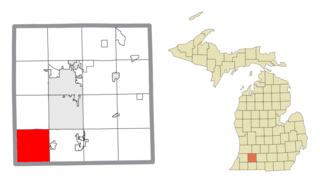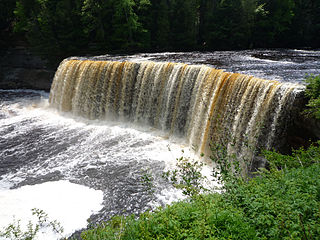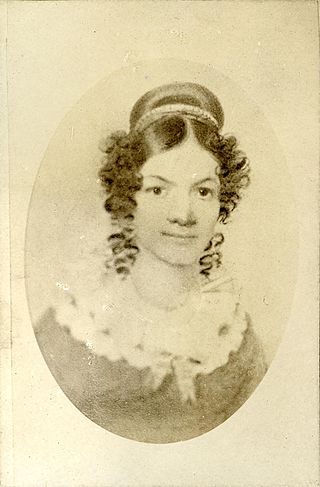Related Research Articles

Tuscola County is a county in the Thumb region of the U.S. state of Michigan. As of the 2020 census, the population was 53,323. The county seat is Caro. The county was created by Michigan Law on April 1, 1840, from land in Sanilac County and attached to Saginaw County for administrative purposes. The Michigan Legislature passed an act on March 2, 1850, that empowered the county residents to organize governmental functions.

Prairie Ronde Township is a civil township located in the southwestern corner of Kalamazoo County in the U.S. state of Michigan. The population was 2,369 at the 2020 census.

The Ojibwe are an Anishinaabe people whose homeland covers much of the Great Lakes region and the northern plains, extending into the subarctic and throughout the northeastern woodlands. Ojibweg, being Indigenous peoples of the Northeastern Woodlands and of the subarctic, are known by several names, including Ojibway or Chippewa. As a large ethnic group, several distinct nations also consider themselves Ojibwe, including the Saulteaux, Nipissings, and Oji-Cree.

The Potawatomi, also spelled Pottawatomi and Pottawatomie, are a Native American people of the Great Plains, upper Mississippi River, and western Great Lakes region. They traditionally speak the Potawatomi language, a member of the Algonquian family. The Potawatomi call themselves Neshnabé, a cognate of the word Anishinaabe. The Potawatomi are part of a long-term alliance, called the Council of Three Fires, with the Ojibwe and Odawa (Ottawa). In the Council of Three Fires, the Potawatomi are considered the "youngest brother". Their people are referred to in this context as Bodéwadmi, a name that means "keepers of the fire" and refers to the council fire of three peoples.

Henry Rowe Schoolcraft was an American geographer, geologist, and ethnologist, noted for his early studies of Native American cultures, as well as for his 1832 expedition to the source of the Mississippi River. He is also noted for his major six-volume study of Native Americans commissioned by Congress and published in the 1850s.

The Odawa are an Indigenous American people who primarily inhabit land in the Eastern Woodlands region, now in jurisdictions of the northeastern United States and southeastern Canada. Their territory long preceded the creation of the current border between the two countries in the 18th and 19th centuries.
The Leelanau Peninsula is a peninsula of the U.S. state of Michigan that extends about 30 miles (50 km) from the western side of the Lower Peninsula of Michigan into Lake Michigan, forming Grand Traverse Bay. It is often referred to as the "little finger" of the mitten-shaped lower peninsula. The peninsula is a tourist hotspot, especially due to the popularity of Sleeping Bear Dunes National Lakeshore, which adorns the southwestern coast of the peninsula. The peninsula is also largely agricultural, and is a production hotspot for cherries and wine.
Match-E-Be-Nash-She-Wish was a hereditary chief of a Potawatomi Indian group in what is now Michigan. The Potawatomi are one of the peoples of the Council of Three Fires; the others are the Odawa and the Ojibwe, all Algonquian-language speakers.

The Anishinaabe are a group of culturally related Indigenous peoples in the Great Lakes region of Canada and the United States. They include the Ojibwe, Odawa, Potawatomi, Mississaugas, Nipissing, and Algonquin peoples. The Anishinaabe speak Anishinaabemowin, or Anishinaabe languages that belong to the Algonquian language family.
Pillager Band of Chippewa Indians are a historical band of Chippewa (Ojibwe) who settled at the headwaters of the Mississippi River in present-day Minnesota. Their name "Pillagers" is a translation of Makandwewininiwag, which literally means "Pillaging Men". The French called them Pilleurs, also a translation of their name. The French and Americans adopted their autonym for their military activities as the advance guard of the Ojibwe in the invasion of the Dakota country.

The Nottawaseppi Huron Band of Potawatomi (NHBP) is a federally-recognized tribe of Potawatomi in the United States. The tribe achieved federal recognition on December 19, 1995, and currently has approximately 1500 members.

The Tahquamenon River is an 89.1-mile-long (143.4 km) blackwater river in the Upper Peninsula of the U.S. state of Michigan. The river flows in a generally eastward direction from the Tahquamenon Lakes of Columbus Township, Luce County to its mouth at Whitefish Bay, a bay of Lake Superior, in Chippewa County. It drains approximately 820 square miles (2,120 km2) of the eastern Upper Peninsula, including large sections of Chippewa and Luce counties, as well as a small portion of Mackinac County. M-123 runs alongside a portion of the river.
Algoma is a placename given to many different places throughout the United States and Canada. Examples include Algoma District, Ontario; Algoma, Oregon; Algoma, Wisconsin; and Algoma Township, Michigan. Algoma also lends its name to companies such as Algoma Steel and Algoma Central Railway.
Lac Courte Oreilles is a large freshwater lake located in northwest Wisconsin in Sawyer County in townships 39 and 40 north, ranges 8 and 9 west. It is irregular in shape, having numerous peninsulas and bays, and is approximately six miles long in a southwest to northeast direction and with a maximum width of about two miles (3 km). Lac Courte Oreilles is 5,039 acres (20.39 km2) in size with a maximum depth of 90 feet (27 m) and a shoreline of 25.4 miles (40.9 km). The lake has a small inlet stream that enters on the northeast shore of the lake and flows from Grindstone Lake, a short distance away to the north. An outlet on the southeast shore of the lake leads through a very short passage to Little Lac Courte Oreilles, then via the Couderay River to the Chippewa River, and ultimately to the Mississippi River at Lake Pepin.

Jane Johnston Schoolcraft, also known as Bamewawagezhikaquay is one of the earliest Native American literary writers. She was of Ojibwe and Scots-Irish ancestry. Her Ojibwe name can also be written as O-bah-bahm-wawa-ge-zhe-go-qua, meaning 'Woman of the Sound [that the stars make] Rushing Through the Sky', from babaam- 'place to place' or bimi- 'along', wewe- 'makes a repeated sound', giizhig 'sky', and ikwe 'woman'. She lived most of her life in Sault Ste. Marie, Michigan.
References
- 1 2 Gannett, Henry (1905). Origin of certain place names in the United States (PDF) (Book, Internet Resource). USGS Bulletin, No. 258, Series F-Geography (Second ed.). Washington: Government Printing Office. p. 171. OCLC 1156805.
- ↑ Michigan Counties, Michigan Department of Natural Resources and Environment.
- ↑ Romig, Walter (1986). Michigan Place Names. Walter Romig. p. 297.
- ↑ Clarke Historical Museum, Kalamazoo etymology, Kalamazoo County Central Michigan University.